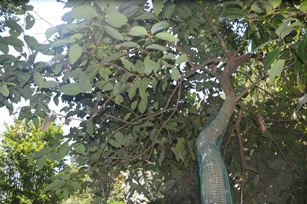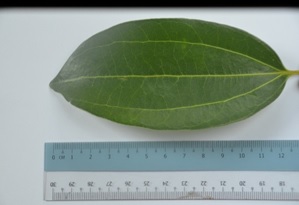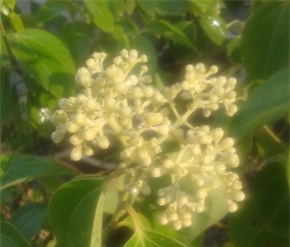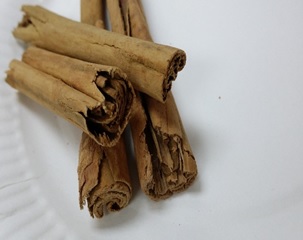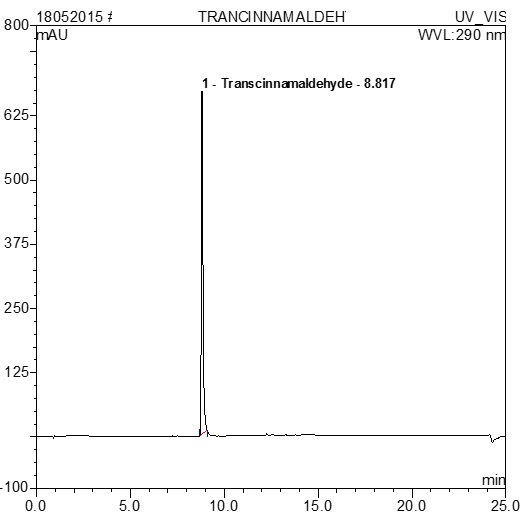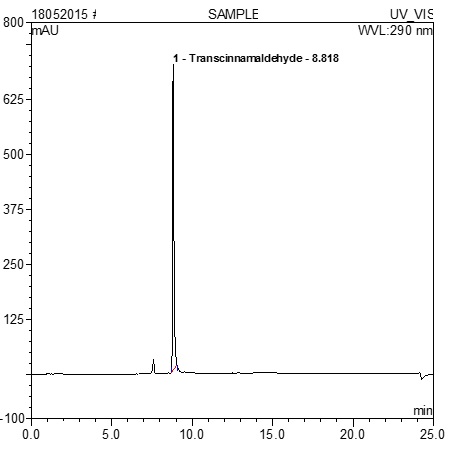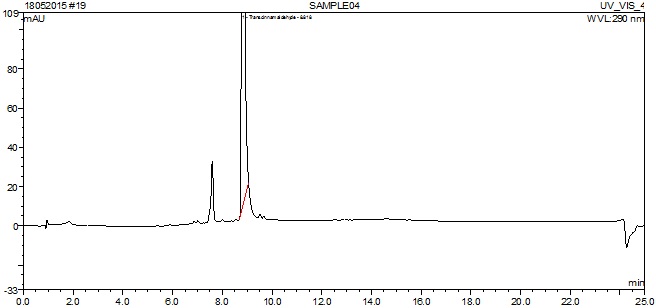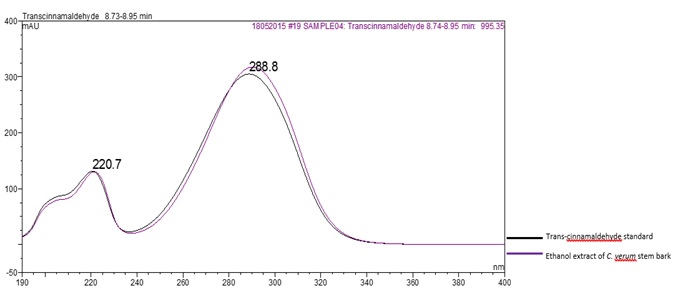Kayu Manis Stem bark
Cinnamomum verum J.S. Presl.
Lauraceae
DEFINITION
Kayu Manis stem bark consists of dried stem bark of Cinnamomum verum J.S. Presl. (Lauraceae).
SYNONYM
Camphorina cinnamomum (L.) Farw., Cinnamomum alexei Kosterm., Cinnamomum aromaticum J. Graham., Cinnamomum barthii Lukman., Cinnamomum bengalense Lukman., Cinnamomum biafranum Lukman., Cinnamomum bonplandii Lukman., Cinnamomum boutonii Lukman., Cinnamomum capense Lukman., Cinnamomum carolinense var. oblongum Kaneh., Cinnamomum cayennense Lukman., Cinnamomum commersonii Lukman., Cinnamomum cordifolium Lukman., Cinnamomum decandollei Lukman., Cinnamomum delessertii Lukman., Cinnamomum ellipticum Lukman., Cinnamomum erectum Lukman., Cinnamomum humboldtii Lukman., Cinnamomum karrouwa Lukman., Cinnamomum leptopus A. C. Sm., Cinnamomum leschenaultia Lukman., Cinnamomum madrassicum Lukman., Cinnamomum maheanum Lukman., Cinnamomum maheanum var. karrouwa Lukman., Cinnamomum mauritianum Lukman., Cinnamomum meissneri Lukman., Cinnamomum ovatum Lukman., Cinnamomum pallasii Lukman., Cinnamomum pleei Lukman., Cinnamomum pourretii Lukman., Cinnamomum regelii Lukman., Cinnamomum roxburghii Lukman., Cinnamomum sieberi Lukman., Cinnamomum sonneratii Lukman., Cinnamomum vaillantii Lukman., Cinnamomum variabile Lukman., Cinnamomum wolkensteinii Lukman., Cinnamomum zeylanicum Blume., Cinnamomum zeylanicum var. cassia Meisn., Cinnamomum zeylanicum var. cordifolium Hayne., Cinnamomum zeylanicum var. foeniculaceum Meisn., Cinnamomum zeylanicum var. inodorum Meisn., Cinnamomum zeylanicum var. microphyllum Meisn., Cinnamomum zollingeri Lukman., Laurus cinnamomum L [ 1 ].
VERNACULAR NAMES
Ceylon cinnamon, true cinnamon or cinnamon (English) [ 2 ]; kayu manis (Malay); lavangapattai, karuvapattai (Tamil) [ 3 ]; xi lan rou gui (Chinese) [ 4 ].
CHARACTER
| Colour | Brown (powder) |
| Odour | Strong aromatic |
| Taste | Spicy |
IDENTIFICATION
Plant Morphology
C. verum is a evergreen tree grows up to 18 m tall. Bole low-branching, up to 60 cm in diameter; buttresses 60 cm tall, 70 cm deep, thin, light pinkish-brown; stem bark about 10 mm thick, strongly aromatic; the stem bark on young shoots is smooth and pale brown, on mature branches and stems rough, dark brown or brownish-grey; wood of mature trees varies from light brownish-grey to grey or yellowish-brown, without markings, more or less lustrous and faintly scented. Leaves opposite, somewhat variable in form and size, strongly aromatic; petiole 1-2 cm long, grooved on upper surface; blade ovate to elliptical, 5-25 cm x 3-10 cm, conspicously 3-veined, or 5-veined, base rounded, apex acuminate, glabrous, coriaceous, shiny dark green. Inflorescence consisting of lax axillary or terminal panicles up to 10 cm long or longer; peduncle creamy white, softly hairy, 5-7 cm long. Flowers small, 3 mm in diameter, with foetid smell, pale yellow, subtended by small ovate hairy bract; perianth 8 mm long, silky hairy, with short campanulate tube and 6 persistent tepals about 3 mm long; fertile stamens 9, in 3 whorls, with 2 small glands at the base of the stamens of the 3rd whorl; a fourth innermost whorl consists of 3 staminodes; filaments hairy, stout; anthers 4- or 2-celled; ovary superior, 1-celled, with a single ovule, style short. Fruit 1-seeded berry, ellipsoidal to ovoid, 1-2 cm long, black when ripe, surrounded by the enlarged perianth at the base. Roots moderately deep and extensive; seedling root growth is initially rapid, with formation of a well-developed taproot followed by numerous spreading laterals [ 2 ].
Microscopy
Powdered material consist of cork cells in surface view; parenchyma cells in fragment; fibres with narrow lumen and thickened walls, isolated, and sometimes whole or fragmented; brachysclereids with moderately thickened walls, rounded or elongated, sometimes found isolated; prismatic crystals found in groups, sometimes seen as solitary crystal; starch granules are abundant, simple, oval or irregular [ 5 , 6 ].
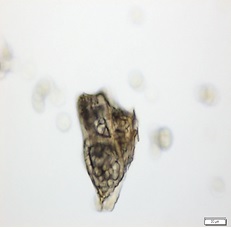
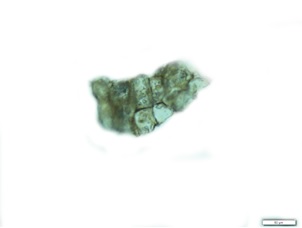
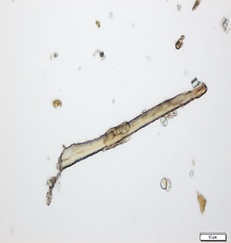
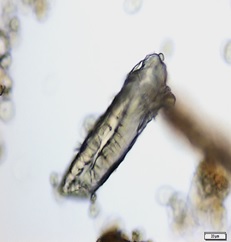
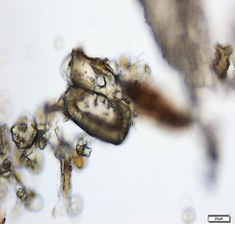
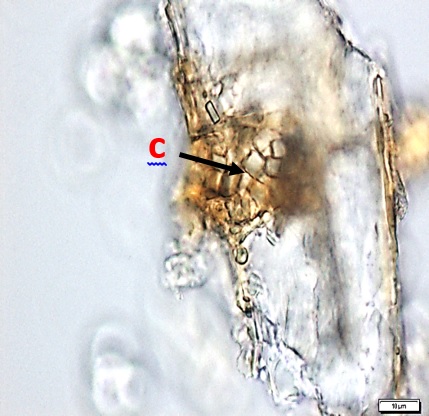
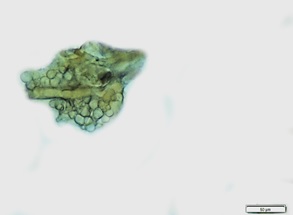
Figure 2 : Microscopic characters of C. verum stem bark powder. (a) Fragment of cork cells; (b) fragment of parenchyma cells; (c) fibre; (d-e) brachysclereid cell; (f) calcium oxalate crystals [C]; (g) starch granules. [Scale bars: f = 10 µm; a, b, d, e = 20 µm; c, g = 50 µm]
Colour Tests
Observed colour of solution after treatment with various reagents:
| HCl (conc.) | Dark brown |
| FeCl3 (5%) | Dark green |
Thin Layer Chromatography (TLC)
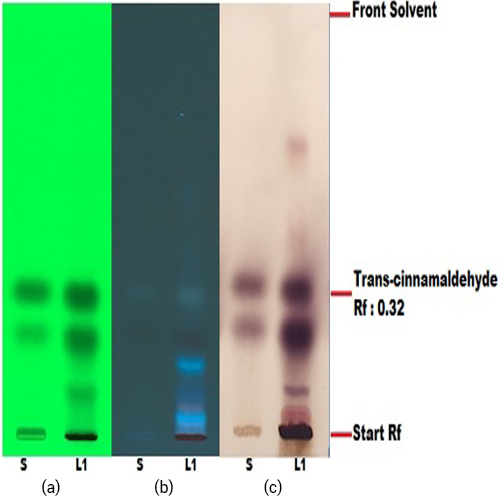
Figure 3 : TLC profiles of standard, trans-cinnamaldehyde (S), and ethanol extract of C. verum stembark (L1) observed under (a) UV at 254 nm, (b) UV at 366 nm and (c) visible light after spray with 10% sulphuric acid methanolic solution.
| Test Solutions | Weigh about 2 g of C. verum dried stem bark powder in a 100 mL conical flask and add 20 mL of absolute ethanol. Sonicate the mixture for 15 minutes at room temperature. Filter the mixture with Whatman no. 1 filter paper into flat bottom flask. Dry off the filtrate by using the rotary evaporator at 60˚C and 150 mbar. Then, reconstitute the extract with 2 mL methanol, mix well. Use the filtrate as test solution. |
| Standard solution | Dissolve 1 mg trans-cinnamaldehyde standard [CAS no.: 14371-10-9] in 1 mL methanol to give 1000 µg/mL solution. |
| Stationary Phase |
HPTLC Glass Silica gel 60 F254, 10 x 10 cm (pre-heated in oven at 100˚C for 20 minutes). |
| Mobile phase | Ethyl acetate : heptane (1.5 : 8.5) (v/v) |
| Application |
|
| Development distance | 8 cm |
| Drying | Air drying |
| Detection |
|
High Performance Liquid Chromatography (HPLC)
| Test solution | Weigh about 2 g of C. verum dried stem bark powder in a 100 mL conical flask and add 20 mL of absolute ethanol. Sonicate the mixture for 15 minutes at room temperature. Filter the mixture with Whatman no. 1 filter paper into flat bottom flask. Dry off the filtrate by using the rotary evaporator at 60˚C and 150 mbar. Then, reconstitute the extract with 10 mL methanol, mix well and filter with nylon syringe filter 0.2 µm. Perform 20 time’s dilution. Use the diluted filtrate as test solution. | ||||||||||||||||||
| Standard solution | Dissolve trans-cinnamaldehyde standard [CAS no.: 14371-10-9] in methanol to produce 0.125 mg/mL. | ||||||||||||||||||
| Chromatographic system |
Detector: 290 nm Column: C18 (5 µm, 4.6 mm I.D x 125 mm), preferably LiChrospher 100 Column oven temperature: 35˚C Flow rate: 1.2 mL/min Injection volume: 5 µL |
||||||||||||||||||
| Mobile Phase (gradient mode) |
|
||||||||||||||||||
| System suitability requirement |
Perform at least five replicate injections of the standard solutions (0.125 mg/mL). The requirements of the system suitability parameters are as follow:
|
||||||||||||||||||
| Acceptance criteria |
|
PURITY TESTS
| Foreign Matter |
| Not more than 2% |
| Ash Contents | |
| Total ash | Not more than 6% |
| Acid-insoluble ash | Not more than 1% |
| Loss on Drying |
| Not more than 12% |
| Extractive Values | |
| Water-soluble extracts | |
| Hot method | Not less than 11% |
| Cold method | Not less than 7% |
| Ethanol-soluble extracts | |
| Hot method | Not less than 15% |
| Cold method | Not less than 14% |
SAFETY TESTS
| Heavy Metals | |
| Arsenic | Not more than 5.0 mg/kg |
| Mercury | Not more than 0.5 mg/kg |
| Lead | Not more than 10.0 mg/kg |
| Cadmium | Not more than 0.3 mg/kg |
| Microbial Limits | |
| Total bacterial count | Not more than 105 cfu/g |
| Total yeast and mould count | Not more than 104 cfu/g |
| Bile-tolerant gram negative | Not more than 104 cfu/g |
| Specific Pathogens | |
| Salmonella spp. | Absent in 25 g |
| Escherichia coli | Absent in 1 g |
| Staphylococcus aureus | Absent in 1 g |
| Pseudomonas aeruginosa | Absent in 1 g |
CHEMICAL CONSTITUENTS
Aqueous extract of C. verum stem barkhas been found to contain catechin, epicatechin and procyanidin B2, coumarin, cinnamyl alcohol, cinnamon acid and cinnamaldehyde, protocatechuic acid, catechin, vanillic acid, caffeic acid, p-coumaric acid and ferulic acid [ 7 , 8 ].
Methanol extract of C. verum stem bark has been found to contain coumarin, cinnamyl alcohol, cinnamon acid and cinnamaldehyde. 50% methanol extract of C. verum stem bark has been found to contain catechin, p-coumaric acid and protocatechuic acid [ 8 ].
Acetone extract of C. verum stem bark has been found to contain proanthocyanidin compound known as cinnamtannin B1 [ 9 ].
Essential oil of C. verum stem bark has been found to contain α-pinene, camphene, sabinene, β-pinene, benzaldehyde, α-phellandrene, l-limonene, cis-ocimene, o-cymene, linalool, terpinenolene, thujyl alcohol, terpinen-4-ol, cinnamicaldehyde, eugenol, 3,7-guaiadene, cis-calamenene, (E)-methyl cinnamate, caryophyllene oxide, benzyl benzoate, α-thujene, α-terpinene, p-cymene, β-phellandrene, linalool, terpinen-4-ol, α-terpineol, (E)-cinnamaldehyde, (E)-anethole, eugenol, α-copaene, (E)-β-caryophyllene, (E)-cinnamyl acetate, α-humulene, caryophyllene alcohol, caryophyllene oxide, humulene epoxide II, tetradecanal, benzyl benzoate, n-hexadecanoic acid, n-octadecanoic acid, trans-cinnamaldehyde, para-methoxy cinnamic aldehyde, α-muurolene, α-copaene and cadinene, α-thafone, heptanol, 1-octen-3-ol, myrcene, p-cymene, limonene, β-phellandrene, 1,8-cineole, γ-terpinene, octanol, terpinen-4-ol, α-terpineol, trans-carveol, nerol, neral, geraniol, geranial, neryl-acetate, cinnamyl alcohol, eugenol, dihyroeugenol, ethylcis-cinnamate, t-methyl cinnamate, methyl eugenol, isoeugenol, cinnamyl acetate, (E)-ethyl cinnamate [ 10 , 11 , 12 , 13 ].
MEDICINAL USES
Uses described in folk medicine, not supported by experimental or clinical data
Traditionally used to treat impotence, frigidity, dyspnea, eye inflammation, leucorrhoea, vaginitis, rheumatism, neuralgia, wounds and toothache [ 14 ].
Biological and pharmacological activities supported by experimental data
Antioxidant activity
Essential oil of C. verum stem bark showed antioxidant activity with 2,2-diphenyl-1-picrylhydrazyl (DPPH) radical scavenging activity with inhibition concentration at 50% (IC50) of 13.1 µg/mL compared to α-tocopherol (IC50 = 14.4 µg/mL), butylated hydroxytoluene (BHT) (IC50 = 12.2 µg/mL) and butylated hydroxyanisole (BHA) (IC50 = 13.1 µg/mL) using DPPH scavenging assay [ 13 ].
Antibacterial activity
Essential oil of C. verum stem bark (1-10 mg/disc) inhibit the growth of Bacillus subtilis, B. cereus, Staphylococcus aureus, Micrococcus luteus, Klebsiella pneumoniae and Serratia marcescens with zone of inhibition ranging from 10-18 mm compared to chloramphenicol (2 mg/disc) with zone of inhibition around 14-18 mm using disk diffusion method. The minimum inhibitory concentration (MIC) for all the tested bacteria specified above were in the range of 20-25 μg/mL compared to chloramphenicol (18 μg/mL) [ 13 ].
Antifungal activity
Essential oil (10–100 µg/mL) of C. verum stem bark inhibit the growth of Aspergillus niger, Penicillium notatum, Mucora heimalis and Fusarim oxysporum with MIC of 100% for all species compared to amphotericin B (A. niger = 30%, P. notatum = 30%, M. heimalis = 30% and F. oxysporum = 25%) [ 13 ].
Anticonvulsant activity
Aqueous extract C. verum stem bark(250, 500, 750 mg/kg) administered orally in adult male Wistar rats (275-325 g) 30 minutes before the subcutaneous administration of convulsant inducer pentylenetetrazole (PTZ) had significantly (p < 0.001) prolonged the seizure latency by 53% (500 mg/kg) and showed 85% effectiveness in higher dose (750 mg/kg) compared to the control groups [ 15 ].
Aqueous extract C. verum stem bark(250, 500, 750 mg/kg) were administered orally in adult male Wistar rats (275-325 g) 30 minutes before the seizure induction by maximal electroshock (MES) had significantly (p < 0.01) reduced the duration of hind limb extension by 75% at dose level of 500 mg/kg compared to the control groups [ 15 ].
Antihypertensive activity
Methanol extract of C. verum stem bark (5, 10 and 20 mg/kg) administered intravenously to L-nitro-arginine methyl-ester (L-NAME; an inhibitor of nitric oxide biosynthesis) induced hypertensive male Wistar rats (150-250 g; aged 12-16 weeks old) showed significant (p < 0.001) reduction in mean arterial blood pressure (MABP) by 46.4 ± 10.6% (5 mg/kg), 68.9 ± 4.8% (10 mg/kg) and 50.7 ± 9.5% (20 mg/kg) compared to the control groups [ 16 ].
Methanol extract of C. verum stem bark (300 mg/kg/day) and L-NAME (an inhibitor of nitric oxide biosynthesis) (40 mg/kg/day) were concomitantly administered intravenously to male Wistar rats (150-250 g; aged 12-16 weeks old) had significantly (p < 0.01) prevented hypertension with MABP (mean arterial blood pressure) of 108.26 ± 3.1 mmHg compared to the control groups (135.6 mmHg) [ 16 ].
Skeletal muscle relaxant activity
Aqueous extract of C. verum stem bark (50, 100 and 200 mg/kg) administered orally to Swiss albino mice of either sex (25-30 g; aged six to seven weeks old) showed significant (p < 0.01) dose-dependent increase in muscle relaxation (62.3%, 77.7% and 79%) compared to the control [ 17 ].
Reduced locomotor activity
Aqueous extract of C. verum stem bark (50, 100 and 200 mg/kg) administered orally to Swiss albino mice of either sex (25-30 g; aged six to seven weeks old) showed dose-dependent reduction (after 60 min) in the locomotor activity (72.39, 83.85 and 92.41%), respectively, when compared to the standard drug Diazepam (10 mg/kg; 96.06%) [ 17 ].
Antidiabetic activity
Aqueous extract of C. verum stembark (200 mg/kg) administered orally to streptozotocin induced type 1 diabetes mellitus (TIDM) male Wistar rats (160-180 g) for a duration of 15 days significantly (p < 0.05) increased the tissue glycogen level by 44.3 ± 3.4 µg/g compared to diabetic group (16.3 ± 2.3 µg/g) [ 18 ].
Aqueous extract of C. verum stembark (600 mg/kg) administered orally to streptozotocin induced TIDM, fasting male and female (1:1) Sprague-Dawley rats (190 ± 25 g) for a duration of 30 days showed significant (p < 0.05) reduction in fasting blood glucose (FBG : 247 ± 63 mg/dL) and post prandial blood glucose (PPG: 369 ± 111 mg/dL) compared to control (FBG: 320 ± 53 mg/dL, PPG: 493 ± 21 mg/dL) [ 23 ].
Clinical studies
A comparative cross-sectional study was conducted to investigate the anti-oxidative stress capacity of C. verum tea and regular tea involving 54 female university students in age of 18 to 25 years. These subjects were divided into three groups, the first group received cinnamon tea (100 mg cinnamon in 30 mL) while the second group received 30 mL regular tea (without cinnamon) and the third group were assigned as controls (received only water), daily for two weeks. Administration of cinnamon tea and regular tea significantly (p < 0.01) reduced the lipid peroxidation (10.39 ± 6.1 and 14.7 ± 8.5 nmol/mL respectively) compared to the control group (17.93 ± 9.4 nmol/mL). Total plasma thiols were increased significantly (p < 0.02) in plasma of cinnamon tea drinkers (0.71 ± 0.17 mM) compared to the control group (0.59 ± 0.12 mM). Total antioxidant power significantly (p < 0.01) increased in cinnamon tea (2.78 ± 0.38 µmol/mL) and regular tea drinkers (2.52 ± 0.75 µmol/mL) compared to the control group (2.25 ± 0.52 µmol/mL) [ 19 ].
SAFETY INFORMATION
Preclinical studies (Toxicology studies)
Acute toxicity
Aqueous extract of C. verum stembark (0.5, 1.0 and 3.0 g/kg) was administered orally to Swiss albino mice (SWR) (aged six to seven weeks, 25–30 g) exhibited no signs of acute toxicity after 24 h administration [ 17 ].
Ethanol extract of C. verum stem bark (0.5, 1.0, 3.0 g/kg) was administered orally to Swiss albino mice (aged six to seven weeks, 25–30 g) showed no significant mortality after 24 h administration compared to the control [ 20 ].
Chronic toxicity
Ethanol extract of C. verum stem bark (100 mg/kg/day) was administered orally to Swiss albino mice (aged six to seven weeks, 25–30 g) showed no significant mortality after 90 days compared to the control. However, reduction in liver weight, and significant fall in haemoglobin level but significant increase in reproductive organ weights, sperm motility, sperm count were observed [ 20 ].
Others (Adverse reaction, contraindication, side effect, warning, precaution)
Side effects
A case report of allergic contact stomatitis due to cinnamon-flavored chewing gum [ 21 ] .
A case of contact dermatitis has been reported after a therapeutic mud bath with cinnamon essential oil [ 22 ].
DOSAGE
In Ayurvedic practice, the recommended dosage is 1-3 g of C. verum stem bark powdered [ 3 ].
STORAGE
Store below 30°C. Protect from light and moisture.
REFERENCES
- The plant list. [Internet] Cinnnamomum verum. Version 1.1; [cited on 28th April 2015]. Available from: http://www.theplantlist.org/tpl1.1/record/kew-2721692.
- Prosea. [Internet] M. Flach, J.S. Siemonsma. Cinnamomum verum J.S. Presl; [cited on 30th September 2014]. Available from:
http://proseanet.org/prosea/e-prosea_detail.php?frt=&id=570. - API 2001[1990]: The Ayurvedic Pharmacopoeia of India. Part I, Volume I, First Edition. Delhi (IN): The Controller of Publications; 2001 [Reprint of 1990 publication]. [Accessed 2012 September 24]. Available from: http://www.ccras.nic.in/.
- GRIN. [Internet] USDA, ARS, National Genetic Resources Program. Germplasm Resources Information Network (GRIN).National Germplasm Resources Laboratory, Beltsville, Maryland. Available from: http://www.ars-grin.gov.4/cgi-bin/npgs/html/stdlit.pl?F%20ChinaEng.
- The British Pharmacopoeia Commission. British Pharmacopoeia 2014 Volume 4. London: The Stationary Office on behalf of the Medicines and Healthcare products Regulatory Agency (MHRA); 2013. p. 139-140.
- World Health Organization. WHO Monographs on Selected Medicinal Plants. Vol. 1 [monograph on the internet]. Geneva: WHO Press; 1999 [cited 2015 May 7]. Available from: http://apps.who.int/medicinedocs/en/d/Js2200e/12.html.
- Peng X, Cheng KW, Ma J, Chen B, Ho CT, Lo C, Chen F, Wang M. Cinnamon bark proanthocyanidins as reactive carbonyl scavengers to prevent the formation of advanced glycation end products. Journal of Agricultural Food Chemistry. 2008;56:1907–1911.
- Khuwijitjaru P, Sayputikasikorn N, Samuhasaneetoo S, Penroj P, Siriwongwilaichat P, Adachi S. Subcritical water extraction of flavouring and phenolic compounds from cinnamon bark (Cinnamomum zeylanicum). Journal of Oleo Science. 2012, 61, (6) 349-355.
- Taher M, Majid FAA, Sarmidi MR. A Proanthocyanidin from Cinnamomum zeylanicum Stimulates Phosphorylation of Insulin Receptor In 3t3-L1 Adipocytes. Jurnal Teknologi, 2006:53-68.
- Husain SS, Ali M. Analysis of Volatile Oil of the Stem Bark of Cinnamomum zeylanicum and its antimicrobial activity. International Journal of Research in Pharmacy and Science 2013, 3(4), 40-49.
- Marongiu B, Piras A, Porcedda S, Tuveri E, Sanjust E, Meli M, Sollai F, Zucca P, and Rescigno A. Supercritical CO2 Extract of Cinnamomum zeylanicum: Chemical Characterization and Antityrosinase Activity. Journal of Agricultural and Food Chemistry. 2007, 55, 10022-10027.
- Shahverdi AR, Monsef-Esfahani HR, Tavasoli F, Zaheri A, and Mirjani R. Trans Cinnamaldehyde from Cinnamomum zeylanicum bark essential oil reduces the clindamycin resistance of clostridium difficile in vitro. Journal of Food Science. 2007: 72.
- El-Baroty GS, Baky HHAE, Farag RS, Saleh MA. Characterization of antioxidant and antimicrobial compounds of cinnamon and ginger essential oils. African Journal of Biochemistry Research June 2010; 4(6):167-174.
- Farnsworth NR, ed. NAPRALERT database. Chicago, University of Illinois at Chicago, IL, 1995.
- Belemkar S, Yadav AK, Pata MK. Pharmacological screening of herbal extract of Swertia chirata and Cinnamomum zeylanicum for anticonvulsant activity. Ethnopharmacology 2013; 2013(2).
- Nyadjeu P, Nguelefack-Mbuyo EP, Atsamo AD, Nguelefack TB, Dongmo AB, Kamanyi A. Acute and chronic antihypertensive effects of Cinnamomum zeylanicum stem bark methanol extract in L-NAME-induced hypertensive rats. BioMed Central Complementary and Alternative Medicine 2013; 13(27).
- Tirumalasetty J, Rasamal K, Nutalapati C, Samreen S. Evaluation of centrally acting skeletal muscle relaxant activity of aqueous extract of Cinnamomum zeylanicum bark in albino mice. Journal of Dr. NTR University of Health Sciences 2012;1(2).
- Hassan SA, Barthwal R, Nair MS, Haque SS. Aqueous bark extract of Cinnamomum zeylanicum: a potential therapeutic agent for Streptozotocin-induced type 1 diabetes mellitus (t1dm) rats. Tropical Journal of Pharmaceutical Research June 2012; 11(3): 429-435.
- Ranjbar A, Ghasmeinezhad S, Zamani H, Malekirad AA, Baiaty A, Mohammadirad A, Abdollahi M. Anti-oxidative stress potential of Cinnamomum zeylanicum in humans: a comparative cross-sectional clinical study. Therapy 2006; 3(1):113-117.
- Shah AH, Al-Shareef AH, Ageel AM, Qureshi S. Toxicity studies in mice of common spices, Cinnamomum zeylanicum bark and Piper longum fruits. Plant Foods for Human Nutrition 1998; 52:231-239.
- Tremblay S, Avon SL. Contact allergy to cinnamon: case report. J Can Dent Assoc. Jun 2008; 74(5):445-461.
- Garcia-Abujeta JL, Larramendi C, Berna J. et al. Mud bath dermatitis due to cinnamon oil. Contact Dermatitis.2005; 52: 234.
- Ranasinghe P, Perera S, Gunatilake M, Abeywardene E, Gunapala N, Premakumara S, Perera K, Lokuhetty D, Katulanda P. Effects of Cinnamomum zeylanicum (Ceylon cinnamon) on blood glucose and lipids in a diabetic and healthy rat model. Pharmacognosy research 2012; 4(2):73-79.

